
Aubusson is a commune in the Creuse department region in central France.

Tapestry is a form of textile art, traditionally woven by hand on a loom. Normally it is used to create images rather than patterns. Tapestry is relatively fragile, and difficult to make, so most historical pieces are intended to hang vertically on a wall, or sometimes horizontally over a piece of furniture such as a table or bed. Some periods made smaller pieces, often long and narrow and used as borders for other textiles. Most weavers use a natural warp thread, such as wool, linen, or cotton. The weft threads are usually wool or cotton but may include silk, gold, silver, or other alternatives.

The Cathedral Church of Saint Michael, commonly known as Coventry Cathedral, is the seat of the Bishop of Coventry and the Diocese of Coventry within the Church of England. The cathedral is located in Coventry, West Midlands, England. The current acting bishop is Ruth Worsley and the current dean is John Witcombe.

A tetramorph is a symbolic arrangement of four differing elements, or the combination of four disparate elements in one unit. The term is derived from the Greek tetra, meaning four, and morph, shape.
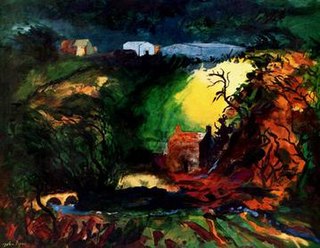
John Egerton Christmas Piper CH was an English painter, printmaker and designer of stained-glass windows and both opera and theatre sets. His work often focused on the British landscape, especially churches and monuments, and included tapestry designs, book jackets, screen prints, photography, fabrics and ceramics. He was educated at Epsom College and trained at the Richmond School of Art followed by the Royal College of Art in London. He turned from abstraction early in his career, concentrating on a more naturalistic but distinctive approach, but often worked in several different styles throughout his career.
Graham Vivian Sutherland was a prolific English artist. Notable for his paintings of abstract landscapes and for his portraits of public figures, Sutherland also worked in other media, including printmaking, tapestry and glass design.

Pietro Perugino, an Italian Renaissance painter of the Umbrian school, developed some of the qualities that found classic expression in the High Renaissance. Raphael became his most famous pupil.
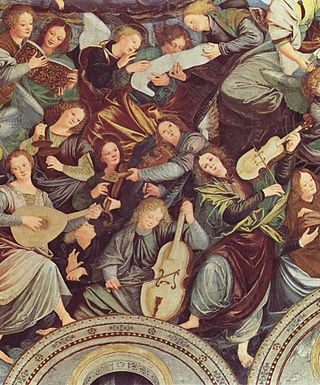
Gaudenzio Ferrari was an Italian painter and sculptor of the Renaissance.

The Unicorn Tapestries or the Hunt of the Unicorn is a series of seven tapestries made in the South Netherlands around 1495–1505, and now in The Cloisters in New York. They were possibly designed in Paris and show a group of noblemen and hunters in pursuit of a unicorn through an idealised French landscape. The tapestries were woven in wool, metallic threads, and silk. The vibrant colours, still evident today, were produced from dye plants: weld (yellow), madder (red), and woad (blue).
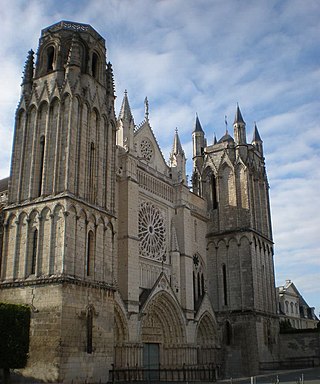
Poitiers Cathedral is a Roman Catholic church in Poitiers, France. It is the seat of the Archbishop of Poitiers.

Andrea della Robbia was an Italian Renaissance sculptor, especially in ceramics.

Christ in Majesty or Christ in Glory is the Western Christian image of Christ seated on a throne as ruler of the world, always seen frontally in the centre of the composition, and often flanked by other sacred figures, whose membership changes over time and according to the context. The image develops from Early Christian art, as a depiction of the Heavenly throne as described in 1 Enoch, Daniel 7, and The Apocalypse of John. In the Byzantine world, the image developed slightly differently into the half-length Christ Pantocrator, "Christ, Ruler of All", a usually unaccompanied figure, and the Deesis, where a full-length enthroned Christ is entreated by Mary and St. John the Baptist, and often other figures. In the West, the evolving composition remains very consistent within each period until the Renaissance, and then remains important until the end of the Baroque, in which the image is ordinarily transported to the sky.
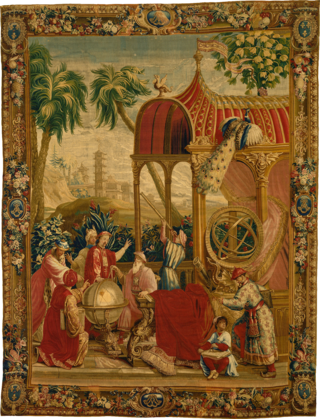
The Beauvais Manufactory is a historic tapestry factory in Beauvais, France. It was the second in importance, after the Gobelins Manufactory, of French tapestry workshops that were established under the general direction of Jean-Baptiste Colbert, the finance minister of Louis XIV. Whereas the royal Gobelins Manufactory executed tapestries for the royal residences and as ambassadorial gifts, the manufacture at Beauvais remained a private enterprise. Beauvais specialised in low-warp tapestry weaving, although the letters patent of 1664, authorising the company and offering royal protection, left the field open for the production of high-warp tapestry as well.
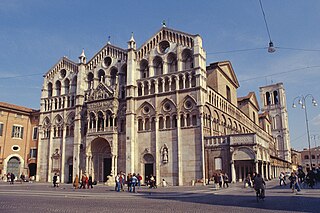
Ferrara Cathedral is a Roman Catholic cathedral and minor basilica in Ferrara, Northern Italy. Dedicated to Saint George, the patron saint of the city, it is the seat of the Archbishop of Ferrara and the largest religious building in the city.

Steven Barry Sykes was a British artist, known for his Gethsemane Chapel in the rebuilt Coventry Cathedral. He was active in the British desert camouflage unit in the Second World War, and was responsible for the dummy railhead at Misheifa and for the effective camouflage and large-scale military deception in the defence of Tobruk in 1942.

Dovecot Studios is a tapestry studio and arts venue in Edinburgh, Scotland.
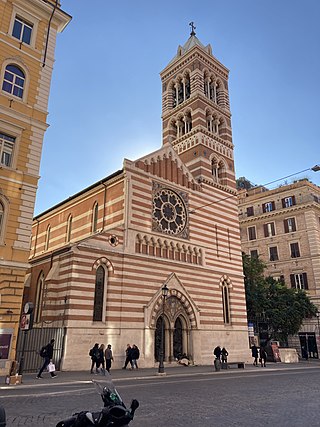
St. Paul's Within the Walls, also known as the American Church in Rome, is a church of the Convocation of Episcopal Churches in Europe on Via Nazionale in Castro Pretorio, Rome. It was the first Protestant church to be built in Rome. Designed by English architect George Edmund Street in Gothic Revival style, it was built in polychrome brick and stone, and completed in 1880.

The Vyšší Brod (Hohenfurth) cycle, ranks among the most important monuments of European Gothic painting. It is made up of nine panel paintings depicting scenes from the Life of Christ, covering his childhood, Passion and resurrection. These paintings were made between 1345 and 1350 in the workshop of the Master of Vyšší Brod that was most probably based in Prague. The pictures were either meant for a square altar retable or else they decorated the choir partition of the church of the Cistercian Abbey in Vyšší Brod.
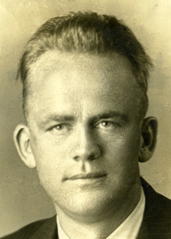
Carl Huneke was a German-American stained glass artist and master craftsman.
Kenneth Lawson was an English artist and set designer.




















